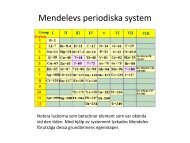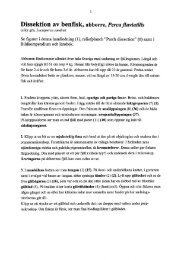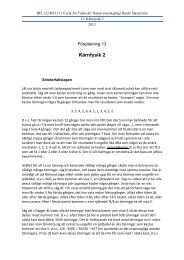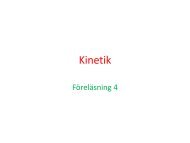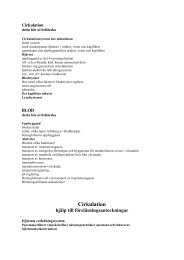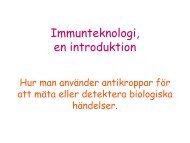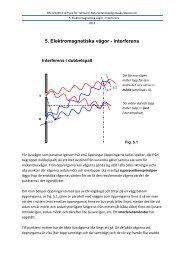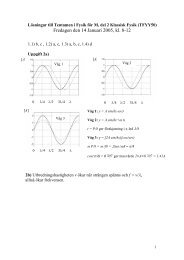Biosensors and Bioelectronics - IFM - Linköping University
Biosensors and Bioelectronics - IFM - Linköping University
Biosensors and Bioelectronics - IFM - Linköping University
You also want an ePaper? Increase the reach of your titles
YUMPU automatically turns print PDFs into web optimized ePapers that Google loves.
<strong>Biosensors</strong> <strong>and</strong><br />
<strong>Bioelectronics</strong><br />
STAFF<br />
Professors: Anthony Turner <strong>and</strong> Fredrik Winquist<br />
Emeritus Professor: Ingemar Lundström<br />
Assistant Professors: Edwin Jager, Ashutosh Tiwari<br />
<strong>and</strong> Valerio Beni<br />
Visiting Researcher: Dr Raeann Gifford<br />
Visiting Scientists: Dr Masoud Mehgardi, Dr<br />
Mohammad Kamyabi, Dr Christine Reinemann<br />
Visiting PhD Students: Aysu Yarman, Sudheesh<br />
Shukla, Silvia Taccola, Daniel Melling<br />
Diploma Student: Henrik Höckerdal<br />
Stipendiat: Christopher Aronsson<br />
Consultant: Dr Claes Nyl<strong>and</strong>er<br />
Managing Editor: Dr Alice Tang<br />
Administrative Staff: Anette Andersson<br />
GENERAL INFORMATION<br />
Our mission is to harness the fundamental<br />
research activities <strong>and</strong> innovation at LiU to<br />
facilitate the creation of the next generation of<br />
bioelectronic devices <strong>and</strong> to support the<br />
national <strong>and</strong> worldwide development of the<br />
field of <strong>Biosensors</strong> <strong>and</strong> <strong>Bioelectronics</strong>. The<br />
broader activities of the <strong>Linköping</strong> <strong>Biosensors</strong><br />
<strong>and</strong> <strong>Bioelectronics</strong> Centre (LBB) are<br />
described elsewhere in this report <strong>and</strong> this<br />
section focuses on our research. We have<br />
exp<strong>and</strong>ed rapidly since our foundation at the<br />
end of 2010, with the development of several<br />
key collaborations, successes in winning<br />
external support, the launch of a new course<br />
<strong>and</strong> the appointment of three new Assistant<br />
Professors <strong>and</strong> a senior Visiting Researcher.<br />
We have hosted a number of international<br />
visitors <strong>and</strong> our international profile is<br />
developing apace. The biosensor laboratory<br />
has been refurbished <strong>and</strong> is now fully<br />
operational. We have purchased a full<br />
spectrum of electroanalytical equipment <strong>and</strong><br />
are acquiring all the facilities necessary to<br />
support our wide ranging research interests.<br />
HIGHLIGHTS<br />
Stimuli-responsive Zipper-like<br />
Nanobioreactors. EU Marie Curie<br />
Fellowship IIF254955: (2011-2013)<br />
This International Incoming Fellowship funds Dr<br />
Ashutosh Tiwari to work on bioreactors <strong>and</strong> stimuliresponsive,<br />
intelligent nano-carriers for<br />
bioelectronics, drug delivery, imaging <strong>and</strong> tissue<br />
engineering. Integrated nanobiosytems are one of the<br />
emerging frontiers in materials science <strong>and</strong><br />
biomedical studies. This area deals with induced<br />
conformational changes in biological structures at<br />
nano dimensions. Temperature, pH, magneto <strong>and</strong><br />
photo switchable nanobioreactors are used to<br />
construct <strong>and</strong> evaluate a new generation of<br />
nanobioreactors. These find application in the<br />
fabrication of high-order diagnostic devices with<br />
switchable nano-bioelectronics <strong>and</strong> modulated<br />
biochemical processing within nano-systems.<br />
Intelligent Nanobioreactors for Auto-switchable<br />
Bio-catalysis. Swedish Research (VR) Council<br />
(2012-16), 4m SEK<br />
This project won in 2011, involves the design of<br />
novel auto-switchable nanobioreactors for the<br />
production of positively responding nano-surfaces<br />
by creating unique “zipper” nanoarchitectures.<br />
Model reactions, with applications in both analysis<br />
(e.g. biosensors) <strong>and</strong> energy production, (e.g.<br />
biological fuel cells) are used as proof-of-principle<br />
platforms in the areas of bioanalysis <strong>and</strong><br />
biocatalysis.The fundamental design behind the<br />
present strategy could make significant contributions<br />
to the advancement of both bio-catalysis <strong>and</strong><br />
material science, leading to self-switching biocatalysis<br />
utilising reusable, cost-effective <strong>and</strong> simply<br />
made materials.<br />
(A) (B)<br />
Auto-switchable<br />
bioreactors<br />
i/A<br />
20 o C<br />
0.0 0.4<br />
E/V<br />
(A) SEM image of self assembled sunflower-shaped<br />
bioreactors <strong>and</strong> (B) cyclovotammograms of<br />
bioreactors at various temperature ranging from 37<br />
to 20 ° C.<br />
Smart Drug Delivery<br />
We are exploring targeted drug delivery using smart<br />
nanocarriers with magnetic resonance imaging<br />
(MRI) <strong>and</strong> hyperthermic properties for tumor<br />
treatment. In general, nanoscopic therapeutic<br />
systems that incorporate therapeutic agents,<br />
molecular targeting <strong>and</strong> diagnostic imaging<br />
capabilities are emerging as the next generation of<br />
multifunctional nanomedicines to improve the<br />
therapeutic outcome of drug therapy. Among the<br />
many nanoparticulate systems, stimuli-responsive<br />
polymeric unimolecular micelles from pH- <strong>and</strong><br />
temperature-responsive block copolymers provide a<br />
unique core-shell architecture wherein the<br />
hydrophobic core serves as a natural carrier<br />
environment for hydrophobic drugs <strong>and</strong> the<br />
hydrophilic shell allows particle stabilisation in<br />
aqueous solution. In addition, it is also possible to<br />
37 o C
introduce a metallic core, giving the particle optical,<br />
magnetic, or hyperthermic properties. The goal of<br />
this programme is to develop unimolecular micelles<br />
with magnetic resonance imaging (MRI) contrast<br />
<strong>and</strong> hyperthermic characteristics for targeted drug<br />
delivery. These novel micelles will be composed of<br />
three key components: (i) a chemotherapeutic agent<br />
doxorubicin that will be released from polymeric<br />
micelles through a pH-dependent mechanism; (ii) a<br />
biological lig<strong>and</strong>, i.e., specific aptamer that can<br />
target tumor cells <strong>and</strong> subsequently induce receptormediated<br />
endocytosis for cell uptake; <strong>and</strong> (iii) a<br />
metallic core for ultrasensitive MRI or hyperthermic<br />
properties.<br />
Molecularly Imprinted Nanoparticles<br />
The high selectivity <strong>and</strong> affinity of molecularlyimprinted<br />
polymer (MIP) nanoparticles offers a<br />
promising approach to develop a new generation of<br />
biosensors, therapeutics <strong>and</strong> imaging agents,<br />
incorporating plastic receptors with desirable<br />
catalytic, affinity <strong>and</strong> DNA sequence-specific<br />
properties. Compared to other types of biosensors,<br />
which use biologically active molecules such as<br />
enzyme, antibody <strong>and</strong> DNA str<strong>and</strong>s immobilised<br />
onto the electrode surface as sensing elements,<br />
biosensors based on MIPs offer three key<br />
advantages: 1) high affinity <strong>and</strong> selectivity to the<br />
imprinted template (i.e., the target molecules); 2)<br />
superior stability compared with those using natural<br />
biomolecules in the biosensor structure; <strong>and</strong> 3) ease<br />
of fabrication <strong>and</strong> adaptation for various types of<br />
biosensors. Our MIP research relates to the<br />
development of biomimetic biosensors, for<br />
biomarkers of disease <strong>and</strong> for the direct detection of<br />
genetic <strong>and</strong> infectious diseases.<br />
(A) Electrochemical preparation of ss-ODN<br />
imprinted MIP electrode <strong>and</strong> (B) Re-usable<br />
biosensor to recognise sequence-specific ss-ODN.<br />
Cardiac troponin immunosensor. LIST (2011-12)<br />
200k SEK.<br />
This project aims to design a tunable cardiac<br />
troponin immunosensor with a sensitivity in the<br />
picograms/mL range or less, <strong>and</strong> a doubleswitchable<br />
cardiac troponin immunosensor using<br />
core-shell nanocomposite. The model strategy will<br />
aid in the effective diagnosis of acute coronary<br />
syndrome. Ideally, it will make significant<br />
contributions to advanced bioelectronics <strong>and</strong><br />
material sciences, leading to construction of ultra<br />
sensitive immunosensors.<br />
Computational Design of Aptamers<br />
Under an ongoing programme of collaboration with<br />
the <strong>University</strong> of Florence, we have elucidated an<br />
entirely new approach to the selection of aptamers<br />
by using computational approach. Starting from<br />
information on the 15-mer thrombin binding<br />
aptamer (TBA), a library of mutated DNA<br />
sequences was generated <strong>and</strong> screened using<br />
Shapegauss a shape-based scoring function from<br />
Openeye Software to generate computationally<br />
derived binding scores. The TBA <strong>and</strong> three other<br />
mutated oligonucleotides, selected on the basis of<br />
their binding score, were incorporated into surface<br />
plasmon resonance (SPR) biosensors. By reducing<br />
the ionic strength in order to match the simulated<br />
condition, the analytical performances of the four<br />
oligonucleotide sequences were compared using<br />
signal amplitude, sensitivity, linearity <strong>and</strong><br />
reproducibility. The experimental results were in<br />
agreement with the simulation findings. This work<br />
could have a significant impact on the efficiency <strong>and</strong><br />
effectiveness of aptamer selection for sensors <strong>and</strong><br />
diagnostics, by facilitating the partial pre-selection<br />
of aptamer sequences to be further tested in an<br />
experimental screening process.<br />
Reagentless Genosensor<br />
Dr. Valerio Beni is collaborating with Prof. Ciara<br />
O'Sullivan, in the development of novel approaches<br />
for performing electrochemical melting curves<br />
analysis. This work, carried out at the Universitat<br />
Rovira i Virgili, Tarragona, Spain aims at the<br />
development of novel electrochemical labels suitable<br />
for conjugation with oligonucleotides <strong>and</strong><br />
subsequent incorporation in PCR products.<br />
The presence of the electrochemical labels will<br />
allow the hybridisation between a PCR product <strong>and</strong><br />
surface immobilised oligonucleotides probes to be<br />
followed as a function of the solution/surface<br />
temperature, using simple <strong>and</strong> inexpensive<br />
hardware.
Loss in hybridisation, melting of the duplex results<br />
in a reduction in the electrochemical response.<br />
Studies of the melting temperature of probe/PCR<br />
product are foreseen as an improved method to<br />
allow rapid <strong>and</strong> effective identification of specific<br />
genetic sequences.<br />
Salivary Amylase (sAA) as a Stress Marker.<br />
NovaMedTech, New Tools for Health <strong>and</strong><br />
Innovation Bridge (2011-2012), 1m SEK.<br />
A pilot study on the associations between sAA,<br />
psychosocial factors, self-rated health <strong>and</strong><br />
inflammation markers has been conducted in<br />
cooperation with researchers at the Health<br />
<strong>University</strong> having a saliva bank within a study called<br />
Life conditions, Stress <strong>and</strong> Health. Levels of sAA<br />
just after awakening were positively associated with<br />
depression scores <strong>and</strong> level of ongoing<br />
inflammation, <strong>and</strong> negatively associated with selfrated<br />
health. Levels of sAA 30 minutes after<br />
awakening <strong>and</strong> just before going to bed point in the<br />
same direction, but may be influenced by recent<br />
daily activity to a higher extent. The findings<br />
support the hypothesis that sAA might be a reliable<br />
marker of ANS activity in saliva.<br />
Reaction kinetics due to amylase activity can be<br />
measured with simple instrumentation using a light<br />
source (LED) <strong>and</strong> a detector (phototransistor) or<br />
with a disposable plastic electrochemical strip.<br />
Preliminary comparison with an established method<br />
for determination of saliva amylase activity is shown<br />
below. Pink triangles = measurements on diluted<br />
saliva, blue = st<strong>and</strong>ard method.<br />
4,00<br />
3,50<br />
3,00<br />
2,50<br />
2,00<br />
1,50<br />
1,00<br />
0,50<br />
Calibration curve<br />
0,00<br />
0 20000 40000 60000 80000 100000 120000<br />
A spin-off has been initiated to develop a<br />
commercially viable biosensor system to monitor<br />
wellness <strong>and</strong> therapy effectiveness <strong>and</strong> about one<br />
million SEK in seed funding from several Swedish<br />
innovation funding agencies has been secured. A<br />
preliminary market study has been completed <strong>and</strong><br />
initial contacts for clinical studies have been<br />
established. With support from LiU Innovations <strong>and</strong><br />
Uppsala <strong>University</strong> patent office, the patent strategy<br />
is underway. Activities continue to develop a<br />
prototype <strong>and</strong> conduct a clinical benefit study, which<br />
are fundamental to demonstrate commercial<br />
viability. The success of this endeavor demonstrates<br />
how our research can generate applications that<br />
improve quality of life <strong>and</strong> increase the<br />
sustainability of healthcare.<br />
Reagent paper Instrumentation<br />
Skin Emissions studies for Bed Sore Prevention.<br />
NovaMedTech<br />
Pressure ulcers are a major problem for bed-ridden<br />
patients, causing pain <strong>and</strong> intense suffering for the<br />
individual. Furthermore, treatment is very costly <strong>and</strong><br />
labour intensive. A lot can be gained therefore if<br />
early precursors of pressure ulcers can be spotted<br />
<strong>and</strong> measures taken before an ulcer occurs. In<br />
collaboration with researchers at the Health<br />
<strong>University</strong> in <strong>Linköping</strong> <strong>and</strong> at the <strong>University</strong> of<br />
Rome “Tor Vergata”, we have performed an initial<br />
study to find out if there is a difference in the<br />
emissions from the skin of compressed tissue<br />
compared with uncompressed tissue. The<br />
experiments were performed on hospitalised patients<br />
in an intensive care unit <strong>and</strong> on healthy volunteers.<br />
This GC-MS study indicates that difference in<br />
general emission patterns are seen between<br />
hospitalised <strong>and</strong> healthy people, respectively.<br />
Furthermore within each group it was possible to<br />
differentiate between compressed <strong>and</strong> uncompressed<br />
tissue. This lays the foundation for the development<br />
of smart technology to prevent this costly <strong>and</strong><br />
damaging trauma.<br />
Artificial Olfaction<br />
A further collaboration with the <strong>University</strong> of Rome<br />
“Tor Vergata” in the area of artificial olfaction <strong>and</strong><br />
colour indicators for volatile organic compounds has<br />
resulted in improved modeling of the olfactory<br />
system based on optical chemical sensing, where<br />
each pixel in a response image is regarded as an<br />
olfactory receptor neuron. Our results indicate that<br />
the average firing rate of the output spike sequences<br />
shows the best separation among the experienced<br />
vapours, however the latency code is able in a<br />
shorter time to correctly discriminate all the tested<br />
volatile compounds. This behavior is qualitatively<br />
similar to those recently found in natural olfaction,<br />
<strong>and</strong> in particular it provides a practical route to tailor<br />
the measurement conditions of artificial olfactory<br />
systems, defining for each specific case a proper<br />
measurement time<br />
<strong>Bioelectronics</strong><br />
We are currently focusing on electroactive surfaces<br />
<strong>and</strong> scaffolds for regenerative medicine as a part of<br />
the LiU Integrative Regenerative Medicine (IGEN)
Center network <strong>and</strong> mechanobiology in<br />
collaboration with Dr. Ana Teixeira’s group at<br />
Karolinska institutet. We have developed new<br />
scaffolds for the electrical stimulation of stems cells<br />
<strong>and</strong> as well as microfabricated devices for<br />
mechanical stimulation of Notch cells.<br />
Actuators<br />
In the field of polymer actuators, we are exploring<br />
the development of new materials, micromechanics<br />
<strong>and</strong> microrobotics, <strong>and</strong> novel actuator designs. We<br />
have developed novel polypyrrole-based actuator<br />
materials <strong>and</strong> currently are investigating the role of<br />
crosslinking in the actuation mechanism. We are<br />
collaborating with Cranfield <strong>University</strong> (UK) on<br />
synthesising <strong>and</strong> quantifying these new materials<br />
<strong>and</strong> with the Italian Institute of Technology, Center<br />
for Micro-BioRobotics, Pontedera, Italy, developing<br />
all polymer soft actuators <strong>and</strong> new bioinspired<br />
propulsion schemes. In addition, Dr. Edwin Jager<br />
spent 2.5 months at the Intelligent Polymer Research<br />
Institute, at <strong>University</strong> of Wollongong, Australia,<br />
working on microfabricating new soft actuators that<br />
work in air. Dr. Edwin Jager is a part of one of the<br />
six remaining FET Flagships, “Robot Companion<br />
for citizens”, which is in its closing phase of drafting<br />
the final application to be submitted in 2012. In<br />
addition, he is an active member of the COST<br />
Action MP1003: European Scientific Network for<br />
Artificial Muscles. He is the national representative<br />
of Sweden in the management committee, chairman<br />
<strong>and</strong> vice-chairman of the medical devices working<br />
group <strong>and</strong> short term training missions working<br />
group, respectively.<br />
COST Action TD1003 Bioinspired<br />
Nanotechnologies: Short Term Scientific Missions<br />
Dr Christine Reinemann (Helmholtz-Centre for<br />
Environmental Research,Leipzig, Germany) visited<br />
to work on novel aptamers for electrochemical<br />
biosensors. A new electrochemical aptasensor was<br />
developed for ethylamines such as diethanolamine,<br />
triethanolamine, ethylamine, diethylamine,<br />
triethylamine, methylamine, lysine <strong>and</strong> arginine.<br />
Aysu Yarman (Fraunhofer-Institut für<br />
BiomedizinischeTechnik, Potsdam, Germany) was<br />
also sponsored by this COST action to visit LiU to<br />
work on peroxygenase or microperoxidase catalysed<br />
substrate conversion of aromatic drugs with<br />
molecular recognition using MIPs. The model<br />
analytes were catechol, diclofenac <strong>and</strong> propanolol.<br />
MIP layers were generated by electropolymerisation<br />
of o-phenylenediamine <strong>and</strong> aminophenyl boronic<br />
acid.<br />
Nanomaterial-based aptasensors for early<br />
diagnosis of prostate cancer<br />
Dr Masoud Mehrgardi (Dept. Chemistry, <strong>University</strong><br />
of Isfahan, Iran) came to the Centre to work on an<br />
RNA aptamer that specifically binds prostate<br />
specific membrane antigen. The aptamer bound to<br />
functionalised gold nanorods, was immobilised on a<br />
gold electrode using 1, 6-hexanedithiol <strong>and</strong> the<br />
impedance followed after incubation with LnCap<br />
<strong>and</strong> PC-3 cell cultures medium. The biosensor was<br />
able to differentiate LnCap cells from PC-3 cells.<br />
3D- Aptamers<br />
nano-probe<br />
Gold nanorods conjugated with PSMA<br />
586.01<br />
Fabrication of a switchable glucose biosensor<br />
based on nanoparticles<br />
Dr Mohammad Kamayabi (Dept. of Chemistry,<br />
Zanjan <strong>University</strong>, Iran) came to work on the design<br />
<strong>and</strong> development of switchable glucose sensors<br />
based on magneto <strong>and</strong> photo responsive polymers<br />
<strong>and</strong> direct electron transfer. In the magnetoswitchable<br />
glucose biosensor, functionalised Fe3O4<br />
or NiO nanoparticles were successfully used to<br />
activate the electrical contact between the redox<br />
units of the enzyme <strong>and</strong> the electrode.<br />
TEACHING<br />
The division of <strong>Biosensors</strong> <strong>and</strong> <strong>Bioelectronics</strong> has<br />
launched a new course on biosensor technology<br />
(Introduction to biosensor technology, TFYA62), for<br />
2 nd year students of the Biomedical Engineering<br />
bachelor degree. The course <strong>and</strong> its associated<br />
practical exercises were designed to stimulate the<br />
interest of the students in the area of biosensors <strong>and</strong><br />
associated technologies in support of this key sector<br />
of the biomedical industry in Sweden. The division<br />
also runs the course Biosensor Technology<br />
(TFTB34) by Fredrik Winquist <strong>and</strong> participated with<br />
several lectures in the course Microsystem<br />
Technology <strong>and</strong> Nanobiology (TFTB33) <strong>and</strong> the<br />
PhD course Organic Electronics (both Edwin Jager).<br />
We also participated in “NanoTechnas” the 5th-<br />
Nanoschool that took place on Vilnius, Lithuania<br />
(15 th -17 th of November).
<strong>Biosensors</strong> <strong>and</strong><br />
<strong>Bioelectronics</strong><br />
Centre<br />
The <strong>Linköping</strong> <strong>Biosensors</strong> <strong>and</strong> <strong>Bioelectronics</strong> Centre<br />
(LBB) was set up in 2010, with the aim of bringing<br />
together the many competences, activities <strong>and</strong><br />
resources at LiU that are already working on, or can<br />
bring valuable contributions to the development of<br />
biosensors <strong>and</strong> bioelectronic devices. The Centre is<br />
also a gateway for international contacts <strong>and</strong><br />
collaborations within this broad <strong>and</strong> rapidly<br />
exp<strong>and</strong>ing field. It has exp<strong>and</strong>ed apace during 2011,<br />
with the development of several key collaborations,<br />
successes in winning external support <strong>and</strong> the<br />
appointment of three new Assistant Professors <strong>and</strong> a<br />
senior Visiting Researcher. It has hosted a number of<br />
international visitors <strong>and</strong> its international profile is<br />
developing rapidly.<br />
Director: Prof Anthony Turner<br />
Professors: Anthony Turner <strong>and</strong> Fredrik Winquist<br />
Emeritus Professor: Ingemar Lundström<br />
Assistant Professors: Edwin Jager, Ashutosh Tiwari<br />
<strong>and</strong> Valerio Beni<br />
Visiting Researcher: Dr Raeann Gifford<br />
Visiting Scientists: Dr Masoud Mehgardi, Dr<br />
Mohammad Kamyabi, Dr Christine Reinemann<br />
Visiting PhD Students: Aysu Yarman, Sudheesh<br />
Shukla, Silvia Taccola, Daniel Melling<br />
Diploma Student: Henrik Höckerdal<br />
Stipendiat: Christopher Aronsson<br />
Consultant: Dr Claes Nyl<strong>and</strong>er<br />
Managing Editor: Dr Alice Tang<br />
Administrative Staff: Anette Andersson<br />
GENERAL INFORMATION<br />
The LBB was set up to capitalise on the experience<br />
<strong>and</strong> potential of <strong>Linköping</strong> <strong>University</strong> (LiU) in the<br />
fields of <strong>Biosensors</strong>, Biosensing <strong>and</strong> <strong>Bioelectronics</strong>.<br />
LiU houses a world-leading group of biosensor<br />
scientists, who have arguably had the most<br />
significant impact on this rapidly exp<strong>and</strong>ing field to<br />
date. Our work on Surface Plasmon Resonance<br />
(SPR) for real-time bioaffinity monitoring <strong>and</strong> on<br />
mediated amperometric biosensors helped establish<br />
the true commercial potential for the field <strong>and</strong> kick<br />
started the current multi-billion dollar industry.<br />
Work continues today across the full range of core<br />
technologies including:<br />
• Bioimaging <strong>and</strong> drug delivery<br />
• Bio-inspired <strong>and</strong> bio-specific lig<strong>and</strong>s<br />
• Biointerfaces<br />
• Biomolecular electronics<br />
• <strong>Biosensors</strong><br />
• Chemical transducers<br />
• Clinical trials<br />
• Printing <strong>and</strong> microfabrication<br />
• Nanomaterials <strong>and</strong> nanostructures<br />
• User interfaces <strong>and</strong> electronic design<br />
LBB’s mission is to harness the fundamental<br />
research activities <strong>and</strong> innovation at LiU to facilitate<br />
the creation of the next generation of bioelectronic<br />
devices <strong>and</strong> to support the national <strong>and</strong> worldwide<br />
development of the field. It is building on the legacy<br />
of S-SENCE, the Swedish Centre of Excellence for<br />
sensor research established at LiU in the mid-90s.<br />
LBB is also working closely with the Joint Research<br />
Centre for <strong>Biosensors</strong> in Singapore, headed by<br />
Professor Bo Liedberg, which was recently set up by<br />
LiU, together with Austrian Institute of Technology<br />
(AIT) <strong>and</strong> Nanyang Technological <strong>University</strong><br />
(NTU). In addition, LBB has formed close links<br />
with the Integrative Centre for Regenerative<br />
Medicine (IGEN) in the Health <strong>University</strong> <strong>and</strong><br />
several joint events have been held resulting in a<br />
number of collaborative grant proposals. LBB also<br />
supports the New Tools for Health initiative <strong>and</strong> has<br />
played a leading role in <strong>Linköping</strong> Center for Life<br />
Science Technologies (LIST), which is chaired by<br />
Prof Lundström. A further key external collaborator<br />
has been the Swedish Defense Research Agency<br />
(FOI). LBB has won a VINNOVA grant together<br />
with FOI to work with Uppsala <strong>University</strong>, Ericsson<br />
<strong>and</strong> two other companies to develop wearable<br />
sensors to assist the elderly.<br />
BIOSENSORS AND BIOELECTRONICS<br />
(ELSEVIER)<br />
LBB is home to the principal journal in the field,<br />
<strong>Biosensors</strong> <strong>and</strong> <strong>Bioelectronics</strong>, published by<br />
Elsevier. Prof Turner is the Editor-In-Chief, Dr Tang<br />
is the Managing Editor <strong>and</strong> Prof Lundström is an<br />
Editor. The journal has the highest Impact Factor<br />
(5.4) for a research publication in the broad field of<br />
Electrochemistry, as defined by ISI, <strong>and</strong> is also the<br />
highest ranking journal in Sensors. The team<br />
h<strong>and</strong>led nearly 2,000 submissions in 2011.<br />
www.elsevier.com/locate/bios<br />
ADVANCED MATERIAL LETTERS (VBRI)<br />
Dr Ashutosh Tiwari is Editor-In-Chief of Advanced<br />
Materials Letters, published by VBRI Press, <strong>and</strong> Dr<br />
Raeann Gifford is an Associate Editor. This new<br />
journal seeks to promote studies of the structure,<br />
synthesis, characterisation <strong>and</strong> application of novel<br />
nanomaterials. Dr Tiwari also edited two books in<br />
this area during 2011.
JOURNAL<br />
VBRI Press<br />
A rapid publication platf orm<br />
ADVANCED<br />
MATERIALS<br />
Letters<br />
Structure, synthesis &<br />
processing, characterization,<br />
advanced-state properties<br />
<strong>and</strong> applications of materials<br />
Copyright © 2012 VBRI Press<br />
Editor-In-Chief<br />
Ashutosh Tiwari<br />
THE INTERNATIONAL CONFERENCE ON<br />
NANOTECHNOLOGY (ICNANO 2011)<br />
LBB, together with the International Association of<br />
Advanced Materials (IAAB), the <strong>University</strong> of Delhi<br />
<strong>and</strong> the journal Advanced Materials Letters,<br />
organised ICNANO in Delhi in December 2011. Dr<br />
Ashutosh Tiwari was General Secretary of the<br />
Conference <strong>and</strong> over 1,500 delegates attended<br />
sessions on optoelectronics, biomaterials <strong>and</strong><br />
biomedicine, advanced materials, fabrication, green<br />
energy <strong>and</strong> the environment, computational<br />
simulation <strong>and</strong> theory, materials characterisation <strong>and</strong><br />
applications of nananotechnology. Prof Turner was<br />
the Honorary Chair <strong>and</strong> he, Prof May Griffith<br />
(IGEN) <strong>and</strong> Dr Raeann Gifford presented Plenary<br />
Lectures.<br />
THE WORLD CONGRESS ON BIOSENSORS<br />
LBB is the co-organiser, together with Elsevier, of<br />
the 22 nd Anniversary World Congress on <strong>Biosensors</strong>,<br />
which will be held in Cancun, Mexico 15-18 May<br />
2012. The World Congress is the largest <strong>and</strong> most<br />
prestigious event in the field <strong>and</strong> is expected to host<br />
a thous<strong>and</strong> delegates. LiU will present a number of<br />
scientific papers at the conference <strong>and</strong> will also<br />
mount an exhibition st<strong>and</strong> to promote the activities<br />
of LiU.<br />
www.biosensors-congress.elsevier.com<br />
EU NETWORK FOR INITIAL<br />
TRAINING IN CHEMICAL<br />
BIOANALYSIS ITN264772: CHEBANNA<br />
This Marie Curie Initial Training Network (ITN)<br />
commenced in December 2010 for four years <strong>and</strong> is<br />
being carried out in collaboration with Cranfield<br />
<strong>University</strong> in the UK, Roche Diagnostics <strong>and</strong> ten<br />
other European partners.<br />
CHEBANA provides a European hub for research<br />
<strong>and</strong> training in the fast developing field of Chemical<br />
Bioanalysis with co-supervised PhD theses,<br />
postdoctoral training, workshops <strong>and</strong> summer<br />
schools to help furnish the highly specialised experts<br />
that are urgently required by European industry.<br />
Chemical Bioanalysis aims to retrieve selective<br />
information out of complex biological systems.<br />
Sensors, probes <strong>and</strong> devices are the future tools of<br />
medicinal diagnostics, environmental monitoring,<br />
food analysis <strong>and</strong> molecular biology. CHEBANA<br />
provides interdisciplinary research training for both<br />
early stage <strong>and</strong> experienced researchers <strong>and</strong> focuses<br />
on the most important techniques in the field:<br />
electrochemistry, fluorescence <strong>and</strong> mass<br />
spectrometry. The research activities are divided into<br />
four overlapping areas:<br />
• Sensor development for the detection of<br />
small analytes<br />
• Monitoring of biomolecular interactions<br />
• Analysis of cellular function<br />
• Development of diagnostic tools<br />
EU COST ACTION TD1003: BIO-INSPIRED<br />
NANOTECHNOLOGIES: FROM CONCEPTS<br />
TO APPLICATIONS<br />
This four-year COST action commenced in 2010,<br />
with Professors Turner <strong>and</strong> Lundström as the<br />
Swedish representatives. This cross-disciplinary<br />
research consortium is constructing multi-scale<br />
structures in order to organise functional materials in<br />
nanodevices. The marriage of top-down <strong>and</strong> bottomup<br />
fabrication methods paves the way to arrange<br />
complex molecular nano units, to electronically<br />
address them <strong>and</strong> integrate them into functional<br />
devices.<br />
Several national <strong>and</strong> international networks <strong>and</strong><br />
foundations are participating in the COST action<br />
including C’Nano GSO, NanoSpain, Portugal Nano,<br />
Phantoms Foundation, SUDOE Interbio, nanoICT<br />
(bioICT Working Group). These networks have the<br />
technical facilities <strong>and</strong> power to provide technical<br />
support to the summer schools, give international<br />
workshops <strong>and</strong> hold meetings with businesses <strong>and</strong><br />
governmental organisations. LBB <strong>and</strong> LIST will<br />
host a joint workshop on Bioinspired<br />
Nanotechnologies for Distributed Diagnostics,<br />
together with the COST Action, in <strong>Linköping</strong>, 26-27<br />
April 2012.<br />
INTERNATIONAL AGREEMENTS<br />
The <strong>Biosensors</strong> <strong>and</strong> <strong>Bioelectronics</strong> Centre signed an<br />
Erasmus agreement with the Universitat Rovira I<br />
Virgili, Tarragona, Spain <strong>and</strong> with the Institute for<br />
bioengineering of Catalonia (Ibec), Barcelona, Spain<br />
for the exchange of postgraduate students.


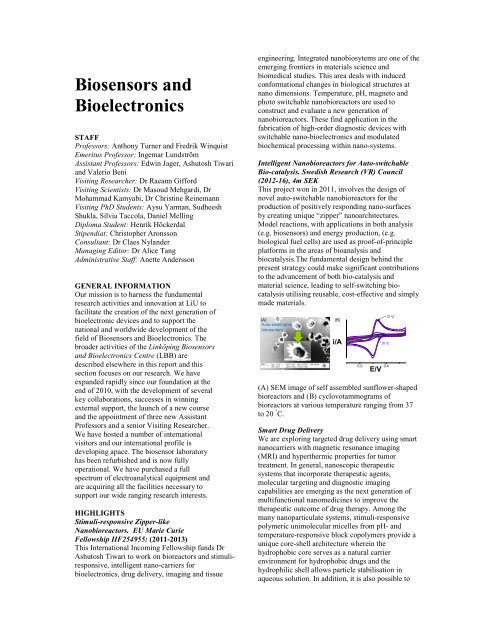
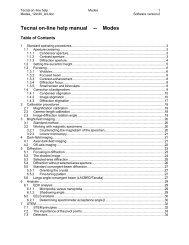
![Read more [PDF] - IFM - Linköping University](https://img.yumpu.com/51852190/1/184x260/read-more-pdf-ifm-linkoping-university.jpg?quality=85)
